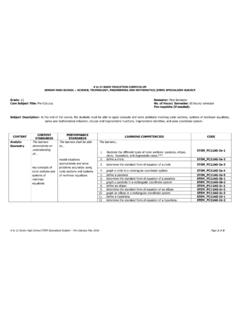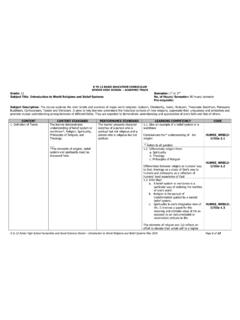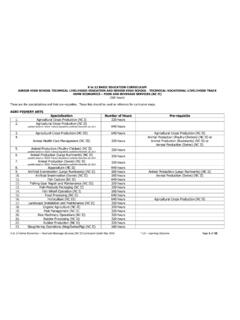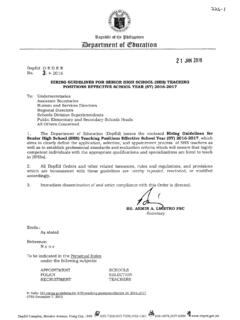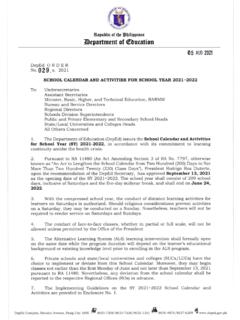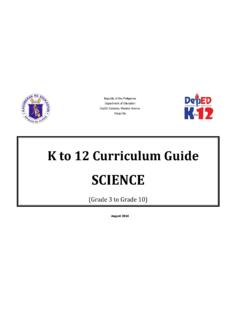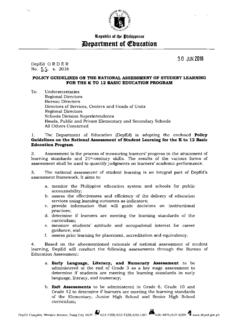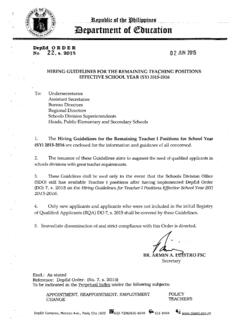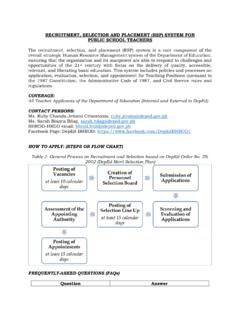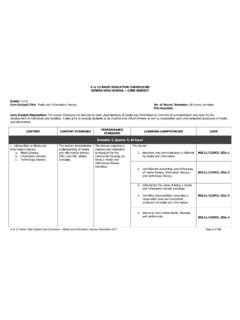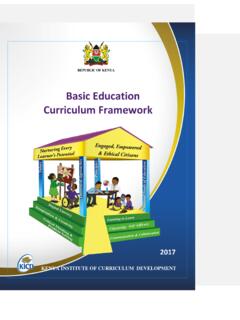Transcription of K to 12 BASIC EDUCATION CURRICULUM SENIOR HIGH …
1 K to 12 BASIC EDUCATION CURRICULUM SENIOR high school CORE SUBJECT K to 12 SENIOR high school Core CURRICULUM Oral Communication in Context December 2013 Page 1 of 7 Grade: 11/12 Semester: 1st Semester Core Subject Title: Oral Communication in Context No. of Hours/ Semester: 80 hours/ semester Pre-requisite: Core Subject Description: The development of listening and speaking skills and strategies for effective communication in various situations. CONTENT CONTENT STANDARD PERFORMANCE STANDARD LEARNING COMPETENCIES CODE Nature and Elements of Communication 1. Definition 2. The Process of Communication 3. Communication Models 4. Five Elements of Communication o Verbal and Non-Verbal Communication 5. Effective Communication Skills 6. Intercultural Communication 6 hours (1 week, 2 days) The understands the nature and elements of oral communication in context. The designs and performs effective controlled and uncontrolled oral communication activities based on context.
2 The 1. Defines communication. EN11/12OC-Ia-1 2. Explains the nature and process of communication. EN11/12OC-Ia-2 3. Differentiates the various models of communication. EN11/12OC-Ia-3 4. Distinguishes the unique feature(s) of one communication process from the other. EN11/12OC-Ia-4 5. Explains why there is a breakdown of communication. EN11/12OC-Ia-5 6. Uses various strategies in order to avoid communication breakdown. EN11/12OC-Ia-6 7. Demonstrates sensitivity to the socio-cultural dimension of communication situation with focus on a. culture b. gender EN11/12OC-Ia-7 EN11 K to 12 BASIC EDUCATION CURRICULUM SENIOR high school CORE SUBJECT K to 12 SENIOR high school Core CURRICULUM Oral Communication in Context December 2013 Page 2 of 7 CONTENT CONTENT STANDARD PERFORMANCE STANDARD LEARNING COMPETENCIES CODE c. age d. social status e. religion EN11 EN11 EN11 EN11 Functions Of Communication Regulation/Control Social Interaction Motivation Information Emotional Expression 16 hours (4 weeks) values the functions/ purposes of oral communication.
3 Writes a 250-word essay of his/her objective observation and evaluation of the various speakers watched and listened to 1. Discusses the functions of communication. EN11/12OC-Ibe-8 2. Identifies the speaker s purpose(s). EN11/12OC-Ibe-9 3. Watches and listens to sample oral communication activities. EN11/12OC-Ibe-10 4. Ascertains the verbal and nonverbal cues that each speaker uses to achieve his/her purpose. EN11/12OC-Ibe-11 5. Comprehends various kinds of oral texts. EN11/12OC-Ibe-12 6. Identifies strategies used by each speaker to convey his/her ideas effectively. EN11/12OC-Ibe-13 7. Evaluates the effectiveness of an oral communication activity. EN11/12OC-Ibe-14 EN11OC-If Communicative Competence Strategies In Various Speech Situations A. Types of Speech context 1. Intrapersonal 2. Interpersonal Dyad Small group 3. Public B. Types of Speech Style 1. Intimate recognizes that communicative competence requires understanding of speech context, speech style, speech act and communicative strategy.
4 Demonstrates effective use of communicative strategy in a variety of speech situations. 1. Identifies the various types of speech context EN11/12OC-Ifj-15 2. Exhibits appropriate verbal and non-verbal behavior in a given speech context EN11/12OC-Ifj-16 3. Distinguishes types of speech style EN11/12OC-Ifj-17 K to 12 BASIC EDUCATION CURRICULUM SENIOR high school CORE SUBJECT K to 12 SENIOR high school Core CURRICULUM Oral Communication in Context December 2013 Page 3 of 7 CONTENT CONTENT STANDARD PERFORMANCE STANDARD LEARNING COMPETENCIES CODE 2. Casual 3. Consultative 4. Formal 5. Frozen C. Types of Speech Act 1. Locution (Utterance) 2. Illocution (Intention) 3. Perlocution (Response) 20 hours (5 weeks) D. Types of Communicative Strategy 1. Nomination 2. Restriction 3. Turn-taking 4. Topic control 5. Topic shifting 6. Repair 7. Termination 16 hours (4 weeks) 4. Identifies social situations in which each speech style is appropriate to use EN11/12OC-Ifj-18 5.
5 Observes the appropriate language forms in using a particular speech style EN11/12OC-Ifj-19 6. Responds appropriately and effectively to a speech act EN11/12OC-Ifj-20 recognizes that communicative competence requires understanding of speech context, speech style, speech act and communicative strategy. demonstrates effective use of communicative strategy in a variety of speech situations. 7. Engages in a communicative situation using acceptable, polite and meaningful communicative strategies EN11/12OC-IIab-21 8. Explains that a shift in speech context, speech style, speech act and communicative strategy affects the following o Language form o Duration of interaction o Relationship of speaker o Role and responsibilities of the speaker o Message o Delivery EN11/12OC-IIab-22 EN11 EN11 EN11 EN11 EN11 EN11 Types of Speeches A. According to purpose o Expository/Informative Speech o Persuasive Speech realizes the rigors of crafting one s speech.
6 Proficiently delivers various speeches using the principles of effective speech delivery 1. Distinguishes types of speeches. EN11/12OC-IIcj-23 K to 12 BASIC EDUCATION CURRICULUM SENIOR high school CORE SUBJECT K to 12 SENIOR high school Core CURRICULUM Oral Communication in Context December 2013 Page 4 of 7 CONTENT CONTENT STANDARD PERFORMANCE STANDARD LEARNING COMPETENCIES CODE o Entertainment Speech B. According to delivery o Reading from a manuscript o Memorized Speech o Impromptu Speech o Extemporaneous Speech C. Principles of Speech Writing o Choosing the Topic o Analyzing the Audience o Sourcing the Information o Outlining and Organizing the Speech Contents D. Principles of Speech Delivery 30 hours (7 weeks) 2. Uses principles of effective speech delivery in different situations. EN11/12OC-IIcj-24 3. Uses principles of effective speech writing focusing on o Audience profile o Logical organization o Duration o Word choice o Grammatical correctness EN11/12OC-IIcj-25 EN11 EN11 EN11 EN11 EN11 4.
7 Uses principles of effective speech delivery focusing on o Articulation o Modulation o Stage Presence o Facial Expressions, Gestures and Movements o Rapport with the audience EN11/12OC-IIcj-26 EN11 EN11 EN11 EN11 EN11 K to 12 BASIC EDUCATION CURRICULUM SENIOR high school CORE SUBJECT K to 12 SENIOR high school Core CURRICULUM Oral Communication in Context December 2013 Page 5 of 7 GLOSSARY Extemporaneous Speech/ Speaking extemporaneously When you speak extemporaneously you are literally making up the words of your speech as you go. That does not mean that you do no preparation. Rather, as you rehearse, you work from an outline or speaker notes that remind you of the progression of ideas in your speech. Impromptu Speech An impromptu speech is given with little or no preparation, usually about a topic that the speaker knows so well. Intercultural Communication - is the sending and receiving of messages across languages and cultures.
8 It is also a negotiated understanding of meaning in human experiences across social systems and societies (Arent, 2009). (Arent, Russell. Bridging the Cross-Cultural Gap Listening and Speaking Tasks for Developing Fluency in English: Michigan ELT, 2009) - is a form of global communication. It is used to describe the wide range of communication problems that naturally appear within an organization made up of individuals from different religious, social, ethnic, and educational backgrounds.. Memorized Speech/ Presenting from memory Unless you have had training and practice memorizing long passages of text, the memorized mode is the hardest to pull off. Freed from a manuscript or notes, you are likely to have the added anxiety of forgetting what you wanted to say. o A memorized speech can also sound "canned" and lacking in spontaneity. After many months of campaigning, a politician's talk will become a memorized talk. o Some speakers are extremely skillful at memorizing.
9 Others, who have presented the same ideas a number of times, will memorize their lines whether they intended to or not. Each time they speak on that or a similar topic, they can draw from memory. This is true for many preachers and teachers. Process of communication According to Niklas Luhmann, communication is the operation, which (re-)produces social systems, it is the central last element (specific operation) for the definition and the retention of society. A change of communicative possibilities by a new medium also changes society. Communication is a synthesis of three components: message, information and understanding: communication comes into being, when its understood that an information is imparted. In the social dimension these components are ascribed to at least two abstracted person. Person a (= ego), who understands, and person b (= alter), who imparts. The imparted information can't be identical to the understood process of communication comes into being, if the preceding communication is followed by a succeeding communication.
10 By these communicative connections constitutes meaning to every process of communication, by selecting one certain connection to all possible connections. Communication needs a spreading medium like speech and writing. Reading from a manuscript/ Speaking from a manuscript According to communication expert Terrence Doyle, reading from a manuscript is the most formal type of delivery. It is also an effective choice when you want to have the greatest control of the wording of your speech. o You will probably use a manuscript when speaking on a highly sensitive topic for which it is important to have precise wording. Or, if you have spent special effort embellishing your speech with stylistic elements, reading from the manuscript will ensure K to 12 BASIC EDUCATION CURRICULUM SENIOR high school CORE SUBJECT K to 12 SENIOR high school Core CURRICULUM Oral Communication in Context December 2013 Page 6 of 7 that you speak the phrases just as you wrote them.
